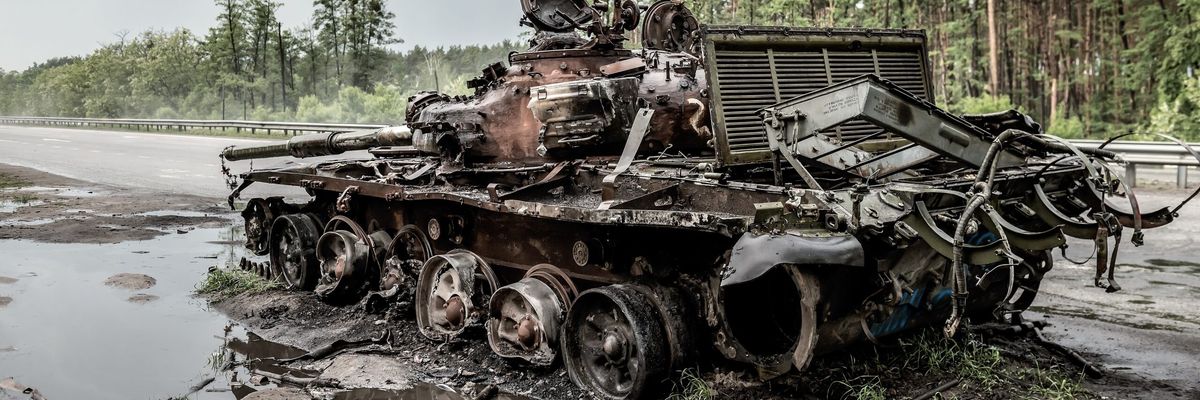In 1998, in the midst of a years-long U.S. campaign to topple Iraqi dictator Saddam Hussein, Gen. Anthony Zinni realized the United States had no actual plan for what would happen in the aftermath. Zinni filled this gap by commissioning a series of war games, which predicted that a post-Saddam Iraq would be plunged into bloody chaos. The analysis, largely ignored at the time, would prove prophetic in the ensuing years.
This is worth recalling now, after long-standing hopes that the Ukraine invasion would spell the end of Vladimir Putin’s rule were nudged closer to reality over the weekend, with Wagner Group leader Yevgeny Prigozhin carrying out a mutiny against the Russian president. The episode brings up several questions: What exactly is America’s plan should the Russian state collapse? What would follow a post-Putin power vacuum? And what measures should the United States take to manage its relationship with the country in such a scenario?
We can get some sense of the foreign policy establishment’s thinking on the subject by looking at what influential think tanks have had to say.
Take the Center for a New American Security, an arms-manufacturer-funded think tank closely aligned with the Democratic Party and from which the Biden administration has drawn many of its top foreign policy appointees. Shortly before Prigozhin’s coup attempt, Andrea Kendall-Taylor, director of its Transatlantic Security Program, co-wrote a piece outlining several scenarios for a post-Putin Russia, drawing heavily on her testimony in a Senate hearing in May.
In one scenario, Kendall-Taylor writes, Putin retains power and eventually dies in office, succeeded by a weak technocrat who changes little from current Russian policy. In another — the course of action she prefers — a Ukrainian military victory triggers a “seismic shift” in the Russian political landscape and galvanizes “a groundswell that could dislodge him,” leading to “the possibility of a more hopeful future for Russia and for its relations with its neighbors and the West.”
Kendall-Taylor admits the odds of a more liberal, democratic Russia emerging from this are “low,” pointing to the 2011 Egyptian revolution that ultimately resulted in Abdel Fattah el-Sisi’s brutal dictatorship. And she acknowledges that if Putin was removed by an armed insurgency, “not only would the aftermath be violent, but the odds of a new dictatorship coming to power would also be high.”
Yet despite the risks “of violence, chaos, and even the chance of a more hard-line government emerging in the Kremlin,” Kendall-Taylor nevertheless concludes that “a better Russia can be produced only by a clear and stark Ukrainian victory,” which will “enable Russians to shed their imperialist ambitions and to teach the country’s future elites a valuable lesson about the limits of military power.” Whatever leader follows, she argues, the West should avoid rushing to stabilize relations and instead demand Russia’s withdrawal from Ukraine, the payment of reparations and the prosecution of war criminals, while aiming to “constrain Russia and its ability to wage aggression beyond its borders” in the long term.
Despite dismissing the risks, Kendall-Taylor is an outlier in acknowledging the potential for violence, instability, and a more hardline government. The Center for European Policy Analysis, another hawkish think tank, has published several pieces since the war began declaring that the possible collapse and disintegration of Russia “will be good for everyone” and that the U.S. goal “should be decolonization,” a popular new shorthand for encouraging its break-up.
Likewise, while insisting it is “essential to prepare” for a coup in Russia, Pavel K. Baev of the Brookings Institution explicitly refuses to consider what he calls the “distinct possibility” of “a catastrophic breakdown of Russia’s autocratic regime and the break-up of this deeply troubled state.” Instead, he asserts that the hardliners around Putin “have neither economic foundation nor public support” to escalate the war, and whoever takes power would simply dispose of them and look for “a way out of the accelerating catastrophe.”
This new leadership, Baev predicts, would make a “series of territorial concessions,” reassess Moscow’s dependence on its nuclear arsenal, and move to restart arms control and strategic stability talks with the United States. Belarussian autocrat Alexander Lukashenko would be replaced by “an unequivocally pro-European government” in the aftermath, in turn leading Moscow to rescind Putin’s September annexation and fully withdraw from Ukraine. Finally, sans Putin, Russia would be less inclined toward confrontation with the West, dealing China a major setback.
Similar predictions abound. Should Putin’s rule collapse, asserts Carl Bildt, co-chair of the European Council on Foreign Relations, “the jingoists will be fighting an uphill battle” while democratic demands will gain steam. A decisive Ukrainian victory could usher in new leadership that “open[s] the door to revived economic partnership with the West,” William Drozdiak, founding executive director of the German Marshall Fund’s Transatlantic Center, writes for the Wilson Center.
Some urge more ambitious plans. William Courtney, senior fellow at the influential and Pentagon-funded RAND Corporation, suggests sanctions should only be eased if Russia withdraws its troops from both Ukraine and Belarus. Rather than draw down U.S. forces in Europe, as was done after the Soviet collapse, the United States should consider “augment[ing] its forces in Central and Eastern Europe” and keeping the door open to further NATO expansion, while engaging Russia’s new leadership on democratic reforms.
Surprisingly more conciliatory is the Center for Strategic and International Studies, a prominent establishment think tank that nonetheless recognizes the grave risks of violence and instability in a Russian power vacuum, and calls for a “careful confidence-building dance” and maintaining a pledge to “welcome back” Russia into Europe if it reforms. (In a less surprising turn, CSIS still insists on maintaining sanctions, continuing military aid to Ukraine and pursuing Russian war criminals in case of a complete Russian collapse.)
In some cases, the predictions and policy suggestions seem at odds. At an event sponsored by the German Marshall Fund last year, analysts reportedly came to a consensus that “a post-Putin Russia would be worse than it is today,” with the possibility of “an even more Stalinist state,” a civil war, and “the disintegration and fragmentation of Russia, with pockets controlled by militias and warlords.”
Yet more recently, the Fund’s nonresident Senior Fellow Bart M. J. Szewczyk has argued that NATO governments primarily “need to step up their efforts to help Ukraine win” without mentioning these dire warnings raised during last year’s event. He dismisses as a “fallacy” that reciprocal security guarantees for Russia are essential for a viable peace and urges using a Russian military defeat to “end the so-called frozen conflict in Moldova, dissolve the Russian puppet statelet of Transnistria, and help Belarus democratize,” as well as to find this generation’s Mikhail Gorbachev, a Russian “successor they can do business with.”
Some common themes stand out. Few consider that what may follow Putin is not just violence and the country’s dissolution, as several experts have warned, but a more hardline government led by hawks more inclined to escalate the war and even less open to rapprochement with the West — and those who do barely dwell on the prospect, sometimes treating the possible negative consequences as an acceptable risk. This is despite the fact that, as Prigozhin’s munity has viscerally reminded us, almost all of Putin’s Russian critics today are more extreme, even ultranationalist. The Atlantic Council only mentions these hawks to urge Russian elites to “move beyond today’s misguided imperialism,” as if it would simply be a matter of will.
Several view Russia’s collapse as less a risk than an opportunity, either to extract concessions from Moscow beyond a withdrawal from Ukraine, or to further weaken and contain Russia. It’s assumed that any instability will play to the West’s advantage, whether by producing a liberal democracy in Belarus or undermining a Chinese government that, it’s presumed, would simply stand by and watch events unfold.
Maybe most striking, there is no mention of how the West can try to resolve the long-simmering grievances that have fed into today’s Russian aggression, or even that it should. Some advocate doubling down on ignoring Russian concerns about NATO expansion. It’s implied such grievances are exclusive to Putin, even though CIA Director William Burns has explicitly said NATO enlargement is widely opposed in Russia, and Gorbachev himself and other Russian liberals have echoed many of Putin’s criticisms of Western foreign policy.
It’s fair to ask whether the U.S. and European foreign policy establishments are repeating the mistakes of Iraq, when overly rosy predictions about the aftermath of regime change left them blindsided by the cascading repercussions of Hussein’s ouster. Those included a civil war and long-running ethnic conflict; the renewal of corrupt, authoritarian rule; a boost to the regional influence of a U.S. adversary; and violence and instability that spread inside and beyond the country’s borders, necessitating more open-ended military commitments, undermining U.S. global standing, and entailing steep human and economic costs.
Similar outcomes would be magnitudes more disastrous in the case of Russia, which is several times larger than Iraq, is more central to the global economy, sits on the world’s largest stockpile of nuclear weapons, is located on Europe’s doorstep, and spans virtually all of Eurasia. We can only hope there’s more serious analysis inside the Pentagon than what’s coming out of Western think tanks.
















